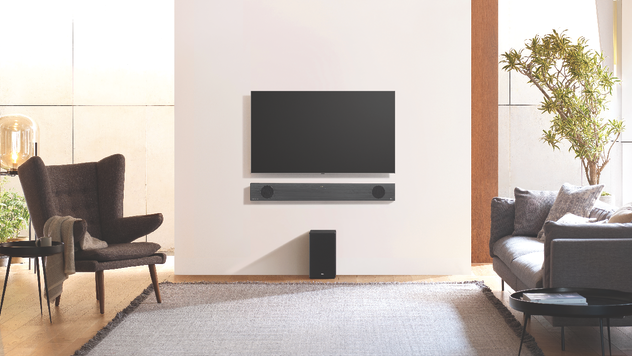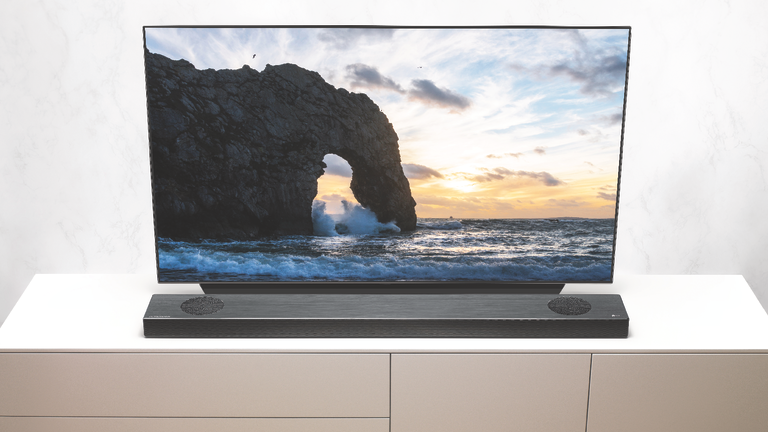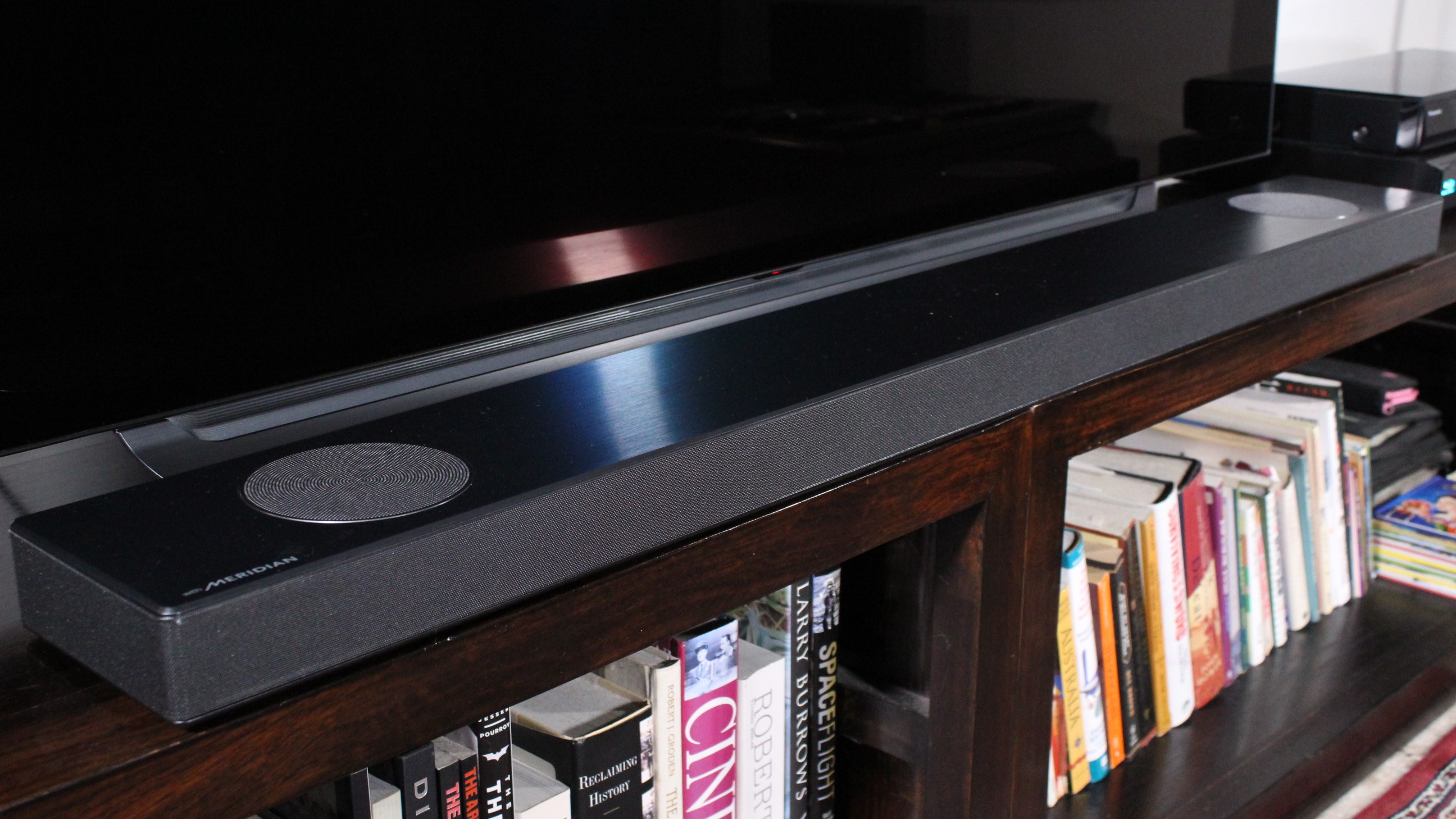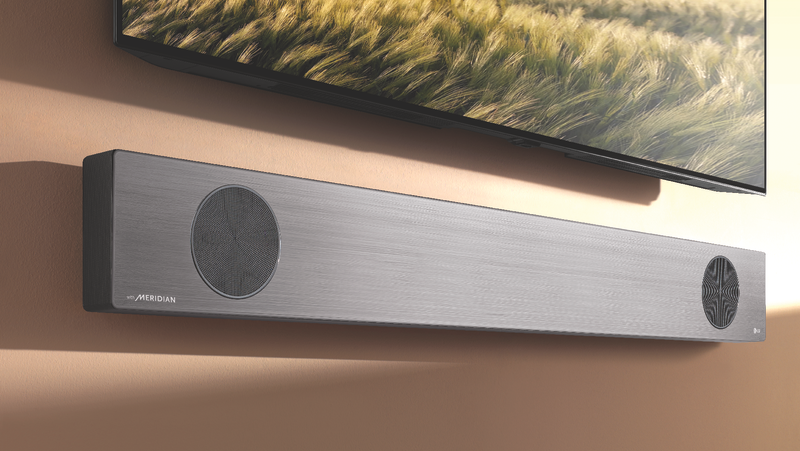TechRadar Verdict
The LG SL9YG ups the immersion factor with support for Dolby Atmos and DTS:X, and morphs into a smart speaker thanks to built-in Google Assistant. A big and bold sound is enhanced by a slim-line design that keeps things sleek, increasing the lifestyle appeal.
Pros
- +
Impressive front soundstage
- +
Dolby Atmos and DTS:X
- +
Google Assistant built-in
- +
Well integrated subwoofer
Cons
- -
Front-heavy acoustics
- -
Limited connections
- -
No eARC/HDR10+ support
Why you can trust TechRadar
The LG SL9YG is the latest addition to the company’s soundbar line-up, and while it retains a number of features from last year - like the Meridian Audio technology and Dolby Atmos decoding found on LG’s 2018 soundbars - it also adds plenty of new ones.
New this year is support for DTS:X, ensuring the SL9YG covers all object-based audio bases. LG has also built-in Google Assistant, turning the soundbar into a fully-functioning and AI-enhanced smart speaker. The newly designed slimline chassis can be installed in two different orientations (which sound processing adjust accordingly), and the result is sleek and lifestyle-friendly.
Design
The LG SL9YG uses a revised design that boasts a much sleeker form factor that’s only 57mm (around 2 inches) high, thus allowing installation in front of a TV without blocking the screen. The chassis is more angular than last year’s LG soundbars, but the build quality remains excellent. There’s a wrap-around mesh grille, and an attractive dark-grey brushed-metal finish.
The front- and side-firing speakers are located behind the mesh grille, and the circular upward-firing drivers are prominently positioned on the top of the soundbar. It measures 1220mm (48 inches) wide, making it ideal for screen sizes of 55-inches or larger, and at 6.3kg (around 14 lbs) it’s fairly heavy. LG includes brackets for mounting the ‘bar vertically against the wall.
In such a scenario the SL9 recognises the different orientation and adjusts the audio processing accordingly. For this reason there are two centrally mounted displays – one on the top and one at the front – and depending on the orientation of the soundbar, one or the other display will be visible. Beneath each of the five-character displays are four LED indicators for Google Assistant.

The SL9YG comes with a dedicated wireless subwoofer. It’s composed of MDF, with three sides covered in black fabric, and a plain dark grey top plate. It uses a 7-inch front-firing driver with a rear port, and it's reasonably well made, but not as solid as the main unit. The sub measures 221 x 390 x 313mm (WxHxD), weighs in at 7.8kg, and should pair automatically with the soundbar.
There are some basic touch sensitive controls located at the top centre of the main unit, beneath the display. These controls allow you to select input, change the volume, turn the power on and off, play/pause, mute the built-in near-field mics, and activate Google Assistant. The latter provides voice control, while LG also provides a handy remote app (iOS and Android).
The diminutive remote control offers large buttons for power, volume, function (for cycling through the inputs) and mute, along with buttons for selecting sound effects, muting the mics, and activating Google Assistant. Under these are a series of smaller buttons for play/pause and skip forwards and backwards, navigating USB file folders, info, repeat, night mode, and sound tuning.
The connections are located in a recessed area on the underside of the soundbar, and are composed of an HDMI input, an HDMI output with ARC, and an optical digital audio input. In terms of wireless connections there’s built-in Wi-Fi (2.4 and 5GHz), Bluetooth (v4.2 SBC) so you can use it as a Bluetooth speaker, and support for Google Chromecast.
Design TL;DR: The sleek design can be installed flat or vertically against the wall, and the audio processing will automatically adjust – which is cool; but the connections are rather limited.

Features
The LG SL9YG uses a 4.1.2-channel speaker configuration, with two forward-firing speakers, two side-firing speakers, and a pair of upward-firing speakers. The latter literally bounce sounds off the ceiling, thus creating the illusion of overhead channels. The ‘point-one’ is delivered by the subwoofer, and the entire system has a total of 500W of amplification.
Since there are only two forward-firing speakers, the SL9 lacks a dedicated centre speaker. However it supports both Dolby Atmos and DTS:X, along with their main variants (aside from IMAX Enhanced DTS:X). The soundbar and subwoofer can deliver 4.1.2 channels out of the box, but those wanting to add rear channels can buy the optional SPK8-S wireless speakers.
The connectivity is fairly basic considering the price, but at least the HDMI ports can pass 4K/60p, 4:4:4, HDCP 2.2, and high dynamic range (specifically HDR10, HLG, and Dolby Vision). While it’s hardly surprising there’s no support for HDR10+ given LG’s disdain for the format, the lack of eARC support is strange considering its 2019 TVs boast HDMI 2.1 inputs.
Along with immersive audio, the SL9 boasts some serious Hi-Fi specs, with support for high resolution audio, a 192kHz/24-bit DAC, and the ability to play back MP3, WAV, AAC/AAC+, AIFF, OGG, and FLAC file formats. There’s also Chromecast built-in, which allows you to cast songs, podcasts and stations from TIDAL, Spotify, YouTube and more.
LG includes a number of sound effects (modes), such as Adaptive Sound Control (ASC), Standard, Music, Movie, and Bass Blast. In addition there’s a Night Mode, Dynamic Range Control, Auto Volume Leveller, and a User EQ. There’s also a Surround mode available that up-mixes non-immersive soundtracks to take advantage of the overhead channels.
The SL9YG has Google Assistant built-in, hence the G at the end of the model number, and as a result you can vocally interact with the soundbar, play music and much more. To get things started just say “Hey Google” or press the Google Assistant buttons on the main unit, controller or remote app. Within seconds you’ll have an AI-enhanced, fully functioning smart speaker at your disposal.
You can install the soundbar horizontally on a surface in front of a TV or vertically against the wall, and the SL9YG will automatically sense the different orientation and optimise the speaker layout. Thanks to Meridian's advanced digital signal processing technology, the soundstage is wider and raised to ear level, even though the front-firing speakers are now facing downwards.
Features TL;DR: The support for Dolby Atmos and DTS:X promises plenty of immersive audio fun; while the built-in Google Assistant makes this more than just a soundbar.

Performance
The LG SL9YG delivers an impressive all-round performance, that’s headed up by a surprisingly musical delivery when it comes to stereo content. Pop on the latest Shakespeare’s Sister single All the Queen’s Horses and the soundbar immediately reproduces the winning mixture of Marcie’s falsetto vocals and Siobhan’s deeper, more throaty delivery. The stereo imaging and detail revival is excellent, and the subwoofer adds a driving bass line that carries the song to its conclusion.
Having established that the SL9 handles the basics well, it was time to try something with more channels. The new Amazon series The Boys has a great 5.1 mix that gave the LG a thorough working out. The soundbar produced an expansive and engaging soundstage that spread music and effects either side – creating a wall of sound. Despite the lack of a dedicated centre speaker, the salty dialogue was delivered clearly (especially Karl Urban’s comedy cockney accent).
There was no real sense of surround envelopment, but given the lack of rear speakers that’s hardly surprising. The side-firing drivers add width but can’t really generate sounds behind you. Engaging the surround mode doesn’t really help in this regard, but it does bring the upward-firing drivers into play. On an aggressive soundtrack like The Boys, this gives the super-powered effects and violence greater impact.
The Netflix series The Haunting of Hill House has a fantastic Dolby Atmos mix that’s delivered to the SL9 via HDMI-ARC from the internal app on an LG 65C8. The episode set in a funeral home during a storm is particularly effective, with thunder rolling overhead, and scary sounds emanating from the sides. Once again the soundstage is restricted to the first third of the room, but the performance is a significant step-up from the TV’s built-in speakers.
The effectiveness of the upward-firing speakers will depend on your room and ceiling. If you have a low reflective ceiling the results can be genuinely impressive, with the speakers bouncing sounds towards the listener and creating the illusion of overhead channels. However if you have a very high or vaulted ceiling, this isn’t the technology for you. The subwoofer also gives the system a powerful bass boost, although this low-end slam is effectively integrated and never overpowering.

The recent 4K Blu-ray of Alita: Battle Angel boasts an energetic Atmos soundtrack that the SL9 delivers with some skill. The score and effects are placed across the front of the room during the Motor-Ball sequence, and there’s some excellent overhead sounds and crowd noises. It’s still decidedly front-heavy, but dialogue remains clear and focused on the screen, while the sub adds weight to the robotic centurions patrolling the streets.
The UHD disc of Waterworld boasts a new DTS:X soundtrack that delivers a full-bodied mix, utilising the full frequency spectrum. Thankfully the SL9 has the power to keep pace with the bass-heavy effects. The score makes extensive use of drums, heavy machine gun fire has a real kick and the jet skis fly overhead thanks to the upward-firing speakers. It's a solid object-based presentation but, as with the Alita the effects are weighted to the front third of the room.
The various sound modes are disabled when the soundbar is decoding an Atmos or DTS:X soundtrack, but they can be very useful with less immersive content. The Adaptive Sound Control (ASC) makes for a useful all-round setting, adjusting the processing depending on the content. The Music and Movie modes do what they say on the tin, as does the Bass Blast, and the Night mode can be useful for not disturbing the rest of the house. Finally the Auto Volume Leveller is handy on commercial channels where advert breaks tend to be deliberately louder.
Performance TL;DR: This powerful bar and sub combo creates a huge wall of sound, despite the lack of centre speaker. The immersive audio is front-heavy, but overall the effect is sure to please.
Value
In terms of sheer performance, the LG SL9YG certainly offers great value with a boisterous immersive audio performance that will delight movie fans. The sound quality is excellent, and the subwoofer delivers a solid bass foundation. The inclusion of Google Assistant is also a nice touch, ensuring the SL9 can do more than simply reproduce soundtracks.
However, in other respects this model seems slightly over-priced when compared to the competition. For a start it lacks a dedicated centre speaker, although that doesn’t seem to have adversely affected the performance. There’s also only one HDMI input, the HDMI output doesn’t support eARC, and the soundbar can’t pass HDR10+.
Other soundbars to consider
The Samsung HW-Q70R is a great alternative to consider because for $800 (£800, AU$1,099) it offers a similar performance and even a few extra features. The Q70 supports Dolby Atmos and DTS:X, thanks to a 3.1.2-channel set-up – which means it has a dedicated centre speaker. Like the SL9 it only has one HDMI input, but it can pass HDR10+. The Samsung might not have a smart assistant built-in, but it can work with Amazon Alexa and it also sounds great with music.
Verdict
The LG SL9YG is an attractive, well-made and highly effective soundbar that has plenty to recommend about it. The sound quality is excellent, with a surprisingly musical performance when it comes to stereo content. As a result you can take full advantage of high-resolution audio and streaming music services delivered via Wi-Fi, Bluetooth or Chromecast.
The 4.1.2-channel configuration does an impressive job of delivering Dolby Atmos and DTS:X immersive audio, creating a big and bold wall of sound at the front of the room. There’s no real sense of sound emanating from the rear, but it’s still an engaging presentation. There’s plenty of bass, and the lack of a dedicated centre speaker hasn’t adversely affected dialogue.
There’s a host of features, but some are more useful than others. Google Assistant is handy, not only providing voice control and making it easy to listen to music, but also turning the SL9 into a fully-functioning smart speaker. Conversely the wall-mounting feature changes the orientation of the speakers, adversely affecting the performance despite some fancy acoustic processing.
- Best soundbars 2019: get the most out of your TV, films, and music
- Take a look at our LG discount codes for the best LG offers and savings.

Stephen is a freelance reviewer with over ten years experience writing for all the major tech publications. As a lifelong film fan he’s embraced the evolution of home entertainment over the decades, and as a professional audio and video calibrator he’s able to keep abreast of the latest developments and innovations. When not reviewing the latest products, Stephen can be found obsessing over how to cram a bigger screen and more speakers into his own home cinema.
